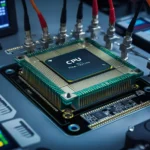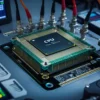Introduction
In today’s digital age, the importance of a processor—commonly known as a Central Processing Unit (CPU)—is undeniable. The CPU acts as the brain of a computer, executing instructions and processing data across a wide array of applications, from mobile devices and laptops to advanced server farms powering cloud technologies. As technology continues to evolve, understanding the intricacies behind CPU manufacturing becomes imperative for industry professionals and tech enthusiasts alike. This article explores the behind-the-scenes intricacies of CPU manufacturing technology, including industry insights, technical innovations, and future prospects.
The Anatomy of a CPU
Before delving into manufacturing details, it’s crucial to understand the basic components of a CPU:
- Control Unit (CU): Directs the operation of the processor and manages the execution of instructions.
- Arithmetic Logic Unit (ALU): Performs all arithmetic and logical operations.
- Registers: Small storage locations within the CPU that hold temporary data needed during processing.
- Cache Memory: A small-sized type of volatile computer memory that provides high-speed data access to the CPU, significantly enhancing performance.
- Interconnect (Bus): System of pathways used for communication between the CPU and other components, like RAM and storage devices.
Understanding these components gives context to the complexities of CPU design and manufacture.
Historical Perspective
Early Development Stages
The evolution of CPU technology began in the 1970s with simple chips like Intel’s 4004, which had a mere 2,300 transistors. Over the decades, CPU manufacturing has undergone revolutionary transformations chiefly driven by the hypothesis known as Moore’s Law—predicting that the number of transistors on a chip would double approximately every two years. This law has consistently guided the industry towards smaller, faster, and more powerful chips.
Transition to Multi-Core Processors
By the early 2000s, increases in clock speeds began to reach physical limits due to heat and power consumption constraints. Consequently, the industry shifted focus towards multi-core architectures, allowing CPUs to handle multiple tasks simultaneously. Modern CPUs now commonly feature quad-core, octa-core, or even more advanced configurations, enabling better multitasking and more efficient processing capabilities.
Technical Innovations in CPU Manufacturing
Semiconductor Technology
The bedrock of CPU manufacturing is semiconductor technology, which hinges on materials like silicon. The process of creating integrated circuits involves a series of steps including:
- Wafer Fabrication: Silicon wafers are sliced from raw silicon ingots and cleaned thoroughly.
- Photolithography: This involves projecting light through masks onto the wafer to transfer circuit patterns.
- Etching and Doping: Areas of the wafer are etched away, and impurities are doped into specific regions to create p-type and n-type semiconductors, which are essential for bipolar junction transistors (BJTs) and field-effect transistors (FETs).
Advanced Fabrication Techniques
Recent advancements have significantly evolved traditional semiconductor manufacturing:
FinFET Technology
With the push towards even smaller transistors, FinFET (Fin Field-Effect Transistor) technology has emerged as a game-changer. Instead of a simple planar structure, FinFETs utilize vertical fins to control current flow, improving power efficiency and reducing leakage current. This innovation has allowed manufacturers to create transistors as small as 5nm.
EUV Lithography
Extreme Ultraviolet (EUV) lithography is another significant advancement, enabling manufacturers to utilize shorter wavelengths of light for chip patterning. This technology allows for more precise etching at smaller scales, facilitating the production of highly intricate chip designs. Companies like ASML are pioneering the EUV lithography process, which could be key to producing chips with smaller geometries well into the 2020s.
3D Chip Architecture
As chip density increases, manufacturers are exploring 3D chip architectures. This design stacks multiple layers of circuits vertically instead of spreading them horizontally on a single plane, enhancing performance and reducing latency. Technologies like Through-Silicon Via (TSV) have emerged to facilitate communication between layers, further improving efficiency and performance.
Industry Insights
Leading Players in CPU Manufacturing
The CPU market features several key players, including:
- Intel: As a historical leader, Intel continues to innovate with its Core family of processors and has started to shift its architecture towards hybrid designs.
- AMD: Advanced Micro Devices has made substantial inroads into the market with its Ryzen and EPYC processors, effectively challenging Intel’s dominance.
- ARM Holdings: ARM’s architecture is widely used in mobile devices and is gaining traction in the server market thanks to its energy-efficient designs.
- NVIDIA: While known primarily for its GPUs, NVIDIA’s focus on AI and machine learning applications has broadened its impact on the CPU landscape.
Market Trends
Several market trends influence CPU manufacturing technology:
-
AI Influence: The growing emphasis on artificial intelligence (AI) and machine learning has propelled the development of specialized computing architectures, like Tensor Processing Units (TPUs) and neuromorphic chips.
-
Sustainability: The tech industry is increasingly focusing on sustainability, with manufacturers exploring energy-efficient processes and recyclable materials to minimize environmental impact.
- Global Supply Chain Dynamics: Recent global events, including the COVID-19 pandemic and geopolitical tensions, have highlighted the vulnerabilities of semiconductor supply chains, leading to a nationwide push for more localized production.
Future Outlook
Quantum Computing
As we look towards the future of computing, the emergence of quantum computing could revolutionize processing capabilities well beyond traditional CPUs. Quantum computers leverage qubits rather than bits, enabling them to perform computations in parallel, which drastically reduces the time required for specific complex calculations.
AI-Driven Design
Artificial intelligence is gradually infiltrating CPU design and testing processes. Machine learning algorithms can analyze vast data sets to optimize chip architecture, performance, and reliability, revolutionizing the manufacturing workflow and cycle times while reducing costs.
Continued Miniaturization
The relentless march toward smaller transistors will continue, with projections that manufacturing nodes will reach 3nm and even smaller in the coming years. This progression will amplify the speed and power efficiency of future CPUs. However, it will also raise challenges in heat dissipation and energy consumption—problems engineers must address effectively.
Conclusion
The landscape of CPU manufacturing technology is an intricate tapestry woven from decades of innovation, engineering prowess, and market demands. As we’ve explored, the journey of CPU development has evolved from simple transistor arrays to complex architectures, incorporating groundbreaking advancements like FinFET and EUV lithography.
The future holds exciting prospects with the potential for quantum computing and AI-driven design approaches, but it also presents challenges, particularly regarding sustainability and supply chain stability. Time will tell how the industry adapts to these changes, ensuring that the next generation of CPUs continues to drive the technological revolution across all industries.
As technology enthusiasts and professionals, staying informed about the subtle nuances shaping CPU manufacturing enables us to better anticipate the innovations that lie ahead. In an ever-evolving digital world, one thing is clear: the heart of every system remains the CPU, and its technological pulse will continue to dictate the pace of progress in our interconnected society.
















